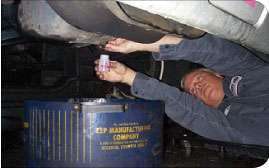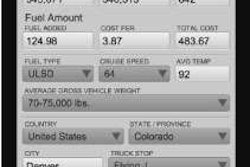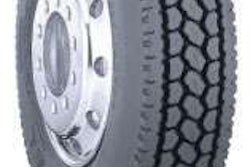I’ve talked with thousands of owner-operators and many fleets about when they change their engine oil and why. The most common answers are 15,000 miles – and a blank stare. Often someone will add, “That’s the way we’ve always done it.”
 Taking an oil sample and getting it analyzed is a key first step in extending drains. Engine makers’ service centers, as well as vendors such as Polaris Laboratories and Blackstone Labs, are good sources for doing the analysis. In some cases, results can be available online in less than a week.
Taking an oil sample and getting it analyzed is a key first step in extending drains. Engine makers’ service centers, as well as vendors such as Polaris Laboratories and Blackstone Labs, are good sources for doing the analysis. In some cases, results can be available online in less than a week.There are only two explanations for changing at 15,000 miles or any other mileage interval: 1) The oil is no good and has already begun to damage the engine. 2) The oil isn’t broken down yet, so good oil is being thrown away. Neither situation makes sense. I believe most of the industry uses these random interval numbers simply because of a lack of knowledge.
If you are going to use some measurement to determine when to change the oil, it should be based on fuel consumed, not miles traveled. Fuel consumed gives a much better indication of how much wear and contamination the oil has been exposed to. A truck that gets 5 mpg puts the oil through more wear and contamination than a truck that gets 8 mpg in the same distance traveled.
The best way to know when engine oil needs to be changed is to take an oil sample, send it to a lab, and let the condition of the oil determine the interval. Doing this allows you to reap some or all of these benefits:
• Maximum usable life of the oil while protecting the engine.

• A reduction in operating costs by safely extending drain intervals.
• Confirmation of the oil’s quality.
• Collection of documentation for warranty claims.
• Identification of driver abuse or negligence, for multi-truck operators.
• Warning signs of engine- and systems-related problems that can’t be identified through normal maintenance.
To achieve maximum benefits from condition-based oil changes and a quality oil analysis program, you should combine them with bypass filtration. This is a secondary system that pulls a small amount of oil and filters it more slowly and thoroughly.
I discovered my first bypass filtration system in 1995 and was convinced that within five years every truck would have one. (It’s a good thing I don’t make predictions for a living!) More than 16 years later, engine manufacturers have only recently started to understand the benefits. Some new engine designs include bypass filtration.
Typical primary full-flow oil filters filter down to 30 to 50 microns. This allows some dirt, metal particles and contaminants to remain and damage engine components. The filters also do nothing to remove liquid contaminants such as coolant, fuel, water and condensation that also can cause damage. This is one reason so many operators change oil so often – even though the oil isn’t worn out, it’s simply too contaminated to do its job.
In contrast, a good quality bypass system can filter down to as low as 2 microns. The best systems include heating elements that can evaporate liquid contaminants and vent them during filtration. Once you install a bypass system, instead of changing your oil at 15,000 miles, you would change only the oil bypass filter and take an oil sample. The filter change and the sample interval are recommended by the bypass system manufacturer.
The system I use has a filter change and sample interval of 25,000 miles. The lab monitors the condition of the oil and recommends when the oil should be changed. It’s not unusual to go 150,000 to 200,000 miles between oil changes.
It’s not hard to see the potential cost savings. Instead of a $200 oil change service every 15,000 miles, you would spend $50 to $60 for a filter change and oil analysis every 25,000 miles. Instead of $1,600 per year in oil changes, you could spend $250 per year for filters and oil samples. It’s great for the environment, too, when you think of all the waste oil saved.
Kevin Rutherford is an accountant, small-fleet owner and the host of “Trucking Business & Beyond,” which airs on Sirius XM Radio’s Road Dog Trucking Radio. Contact Rutherford through his website, LetsTruck.com.











